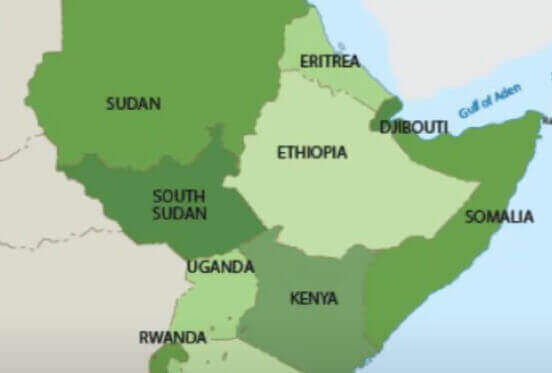By Dr. Suleiman Walhad
October 8th, 2023
The Northern Indian Ocean region, at times referred to as the Somali Sea is a vital link in global trade. This was the case since time immemorial when merchants of the Horn of Africa States would pick up goods from India and South Asia and pass them on to others such as Europe through the Greeks and later through Rome sometimes via Arabia and at other times through the Red Sea and then Egypt. The Greeks thought that Cinamon was a Horn of Africa product when, indeed, they brought it from India and/or Sri Lanka and then traded it with the Greeks, and hence the Greeks called the region of the Horn of Africa “the Land of Cinnamon”.
The Horn of Africa States region had always had a multidimensional relationship with India and South Asia in general involving not only trade in goods and services but also military and naval invasions from one side to the other on several occasions in ancient history. This relationship was affected by the monsoons, the Beden, and other trade ships, and the many parties that got involved in this business including the Horn Africans, Egyptians, Indians, other South Asians, Europeans, Arabs, and Persians. The Northern Indian Ocean could, as a matter of fact, be described as the home of the first global trade basin, with all these parties playing their roles in extensive and expansive trading activities, people travel, and the spread of belief systems.
The trade routes in the region not only involved trade in goods but also as a route for the transfer of animals and plants from one part to another and even for the transmission of cultural belief systems across the vast space of the Northern Indian Ocean. It was, indeed, a microworld of its own for millennia, which has brought in the current state of the Ocean and its continuing influences on global interactions among the powers of today.
The Northern Indian Ocean saw Islam dominate its entire coastal cities and populations for centuries from the eighth to the 14th centuries when it was known as the “Islamic Sea”, only to be replaced by European influences since then, wherein at one time, it was often referred to as the “British Lake” from the late 1800s to the end of the first half of the twentieth century. Competition and more particularly naval competition and influences around the Northern Indian Ocean continued after the Second World War between the contenders for supremacy of those years – NATO under the USA leadership and the now defunct Warsaw Pact under the leadership of the Ex-Soviet Union.
The Northern Indian Ocean is as important for global trade and the global economy as it was millennia ago and competition currently runs between China, the USA, and other emerging powers like India itself, the UAE, Turkey, Saudi Arabia, and others such as the European countries of Spain and France. Of course, each of these main contenders carries along its allies and partners with it. The competition remains complex but markedly points to the absence of the Horn of Africa States region as opposed to its history with respect to this stretch of an important waterway.
The Horn of Africa States region, which has the longest coast in the region, has the least influence and/or activities except for perhaps the recently concluded terror groups, that sprung up in the region, which terror groups and pirates seem to have been operated from beyond the region and blamed on innocent populations living off its coastal regions, but which gave the excuse for foreign naval forces to invade the region protecting enormous fishing trawlers from other parts of the world. This weak position of the region also brought claims of others on its seas and coasts, which even went to the International Court of Justice in The Haque for settlement.
The region, despite owning such vast water space, and an EEZ of nearly a million square kilometers, is reported on a regular basis to be affected by hunger, and lack of food, and even international organizations like the FAO add on to these regular calls, although they know of the availability of food and the lack of skills to exploit it in the region and its seas. Government infrastructures have been weakened through constant and continuing conflicts mostly engineered from outside using the idiosyncrasies of the region.
The Northern Indian Ocean of the twenty-first century will not be less important than its histories of the centuries or even millennia before. It has always been an arena of human interactions, migrations and cultural exchanges, trade, and source of food for millions of people along its coasts. It will continue to be so in the coming future. It is a region of extreme diversity and walled on three sides by lands. It is reported to hold 40 percent of the world’s energy reserves, 65 percent of strategic raw material reserves, and an extremely strategic location where global competitors of the world are expected to play out their struggles (Read: The Indian Ocean Geopolitics by Dhanushka Rodrigo, February 11, 2021).
The Horn of Africa States, would, therefore, be affected by the machinations of outside actors in the Indian Ocean. There is already a multitude of naval presence in the region and general proxy struggles among these various and diverse actors would no doubt affect the region, causing it more headaches than it already has with its own internal conflicts of clan/tribal competitions for power.
The one major absence of all this remains to be the lack of a regional platform not only to lay down a regional approach with respect to its seas but also to address its security, economic development, and exploitation of its natural resources both offshore and onshore. The future of the Northern Indian Ocean would then depend on non-regional parties for a considerable period of time to come and the region would be as helpless as it has been in the past three to four decades.


















Another well researched masterpiece by Brother Dr. Suleiman Walhad. I have been bookmarking his articles since the first time I had the privilege to read them.
Thank you sir, for educating us.